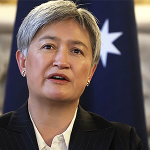One of the great aberrations of the executive state is the obstinacy, determination, and poll-driven enthusiasm with which governments (both Labor and Coalition) promote the Net Zero fantasy demanded by the Paris Agreement of 2015 – a toothless tiger as there are no penalties for non-compliance. This is a monstrous aberration because there is incontrovertible evidence that carbon dioxide, CO2, does not have a perceptible effect on the Earth’s temperature. One of the authors of this opinion piece has demonstrated in an article published in Science of Climate Change that ‘the relationship between increasing global concentrations of CO2 and increasing global temperatures … has been shown to be tenuous at least, and most likely, absent’ and that ‘the increasing concentrations of global atmospheric CO2, regardless of its sources, should no longer be of global concern to humanity now and into the future’.
These scientific studies reveal that there is no climate emergency, just a man-made political weapon polluting the minds of the ill-informed and gullible, and allowing politicians and others to pursue their Net Zero fantasies for no other reason than to garner votes from an ill-informed electorate. However, the demonisation of coal-fired power stations, in the rush to develop a renewables industry and to make Australia a ‘renewables superpower’ (an oxymoron – renewables and superpower are mutually exclusive), continues unabated.
But, during the last couple of weeks, the government’s renewables mania has been jolted by the Coalition’s announcement that it would build seven nuclear reactors on the site of decommissioned coal-fired power stations if it were to win government. Apart from overcoming the existing legislative ban on the building of nuclear power plants, the debate has centred around issues that cloud the future of nuclear energy in Australia. The uppermost concerns are the safety of these reactors and the disposal of radioactive waste. Others are the high upfront cost and construction time of building nuclear reactors.
One of the most cynical arguments against nuclear energy is that ‘introducing nuclear power into the mix … undermines the business case and the returns on investments in wind, solar and batteries that have already been made’. If so, the ‘pressure on the Coalition to walk back its nuclear policy if it wins government will be nothing short of overwhelming’.
However, a serious concern with the proposed building of nuclear reactors is not that it might derail Australia’s renewables industry, but instead it is the possibility that reactors might explode and devastate the surrounding area. The possibility that they may get out of control and spread radiation into the surrounding area is at the forefront of any debate about nuclear energy.
There have been three major nuclear power plant accidents since 1979: Chernobyl (Ukraine), Fukushima (Japan), and Three Mile (United States). The major causes of those three accidents can be summarised as being due to a combination of design flaws, operator errors, sloppy procedures, and in the case of Fukushima, the location of the reactor. The causes of these accidents have been thoroughly investigated and changes to the design, operation and safety of nuclear reactors based on the lessons learned from those accidents have made nuclear power plants extremely safe. Since the three nuclear power plant accidents occurred, modern nuclear reactors are being designed with multiple layers of safety systems to prevent such accidents and mitigate any consequences. These include redundant cooling systems, containment structures, and passive safety features that can operate without external power.
Strict operational protocols and rigorous training ensure that nuclear reactors are operated safely. Procedures are in place to handle routine operations, emergencies, and abnormal conditions. Extensive risk assessments are conducted to identify potential hazards and vulnerabilities in nuclear power plants. Risk management strategies are implemented to reduce the likelihood and consequences of accidents.
The Chernobyl disaster was a result of a complex interplay of technical, operational, and organisational failures. It highlighted the importance of rigorous safety protocols, proper reactor design, and a culture of transparency and accountability in nuclear operations. The Fukushima accident was caused by an inept decision to build a nuclear power plant in an area known to be vulnerable to tsunamis and earthquakes.
Nuclear power plants, like aircraft or any other man-made structure such as dams, carry inherent risks, primarily related to the potential for accidents that could release radioactive materials. But we live in a radioactive world, and we must learn to live with managing safe levels of radioactivity.
Australia has built and operated two nuclear reactors safely at Lucas Heights in New South Wales since 1958. OPAL is Australia’s only nuclear reactor and plays a key role in nuclear research, production of medical isotopes, and neutron beam research.
This reactor incorporates multiple safety systems including redundant cooling systems, automatic shutdown mechanisms, and containment structures to mitigate the consequences of any abnormal events. Personnel working at Lucas Heights undergo rigorous training and certification processes to ensure they are qualified to operate and respond to emergencies at the reactor facility.
Although these facts alone should provide sufficient justification to build nuclear power plants as needed, there is a conflict of advice between CSIRO and the Coalition concerning the cost of building nuclear reactors and the time it will take to build them. According to a CSIRO report, it would cost at least $8.5 billion to build a large-scale nuclear reactor in Australia, and nuclear power is estimated ‘to be at least 50 per cent more expensive than wind and solar power backed by batteries’. However, research undertaken by the Institute of Public Affairs disputes this estimation. ‘Australia’s decision-makers have deluded themselves for far too long that the CSIRO’s GenCost modelling is an accurate and reliable basis to design Australia’s energy future,’ said the Executive Director of the Institute.
Should reactors be built in the seven locations in Australia chosen by the Coalition – reactors that will be designed to be safe, long-lasting, and operated intelligently – it is highly unlikely that any serious accidents involving those reactors will occur. But a far better plan is to utilise the vast energy contained in fossil fuels, upgrade and maintain our workhorses, our coal-fired power stations, and transition into nuclear energy in a manner that stays in tune with supply of well-trained technicians and the minerals and energy raw materials needed to make a successful transition.
Although it is thus possible to overcome the perceived, or real, disadvantages of nuclear energy, the existing coal-fired power stations which are in the process of decommissioning are infinitely safer, healthier, and less costly, and continue to serve the Australian economy well. Hence, the introduction of nuclear reactors in the energy mix is the second stage of restoring cheap, reliable energy to rescue this country from a future of blackouts and economic collapse.
In this context, ‘The duplicitously-named “renewables” juggernaut is stamping across the country with a destructive footprint like no other. The derided carbon footprint is green grass, native forests, pasture and grazing lands.’ We need not only nuclear fission, but a new-clear vision and continue to use fossil fuels – solidified sunlight – to benefit mankind and life on this planet until a smooth transition can be made. The only climate we can control is within enclosures we make, using power we can access. The climate control panel for the planet is outside of our control. With apologies to Dorothea Mackellar:
I loathe a glass-clad landscape, a land of shiny panes
That all need window cleaners, and don’t work, when it rains.








